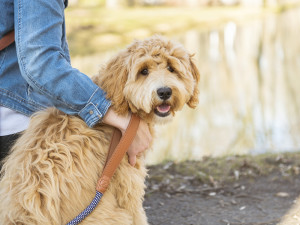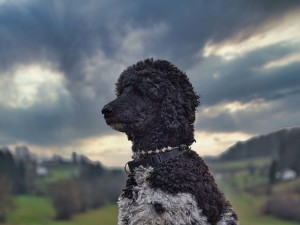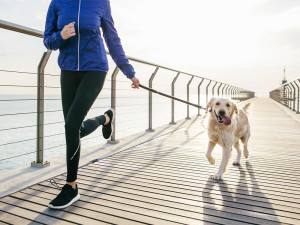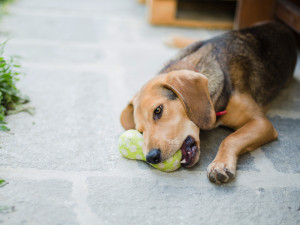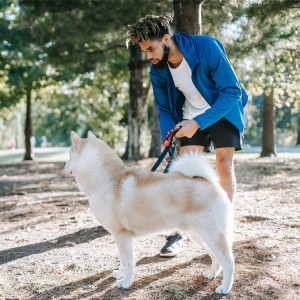Born This Way: How to Meet The Needs of Your Dog’s Breed
Different breeds need different things...

Share Article
Understanding your dog’s breedopens in a new tab brings humans and dogs closer. Not only is working out their weird and wonderful behaviours a way of strengthening your relationshipopens in a new tab but it also ensures that their specific needs are met – which is crucial for their happiness and well-being.
Different breeds have unique characteristics, traits and requirements (and personalities!) that influence their behaviour and overall health. Breed fulfilment involves recognising these needs and providing appropriate physical and mental stimulation. We delve into the importance of breed fulfilment, how to achieve it and what you might’ve been getting wrong.

littleKin™ is Kinship’s home just for puppy and kitten parents. Bop over to check out expert advice, new pet tools, and special deals—all curated for your newest family member.
opens in a new tabWhat is breed fulfilment?
Breed fulfilment refers to the practice of meeting the specific physical, mental and emotional needs inherent to your dog’s breed. Each breed was originally developed for particular roles, whether herding, hunting, guarding or companionship. For instance, although your pampered Greyhoundopens in a new tab might prefer having their food brought to them on a silver platter these days, Greyhounds were originally bred to hunt small mammals using their sight and speed.
Understanding these roles and the associated behaviours helps pet parents provide activities and environments that align with their dog’s natural instincts. Fulfilling these needs not only prevents behavioural issues but also enhances the overall quality of life for the dog. “The breed will always affect the hereditary behaviour,” says dog behaviourist Ria Edmenson. “All dogs are bred for a purpose so knowing what your dog’s purpose is, is essential for being able to provide the best quality of life for them.”
Why breed fulfilment matters
Before anything else, breed fulfilment can be the first step in preventing behavioural issues that can arise from unmet needs. For instance, working breeds such as Border Collies or German Shepherds require significant mental and physical exercise. Without proper fulfilment, these dogs may develop destructive behaviours out of boredom or frustration.
Studies have shown that breed-specific behaviours are deeply ingrained. A comprehensive study on UK designer crossbreed dogsopens in a new tab found that pre-purchase motivations (the reasons why a pet parent might want to adopt that specific breed) and understanding of breed traits significantly influenced owner satisfaction and dog behaviouropens in a new tab. Getting to know breed-specific behaviours before buying or adopting your pup will help your bond and their behaviour down the road.
“For example – did you get your Cockapoo or Labradoodle because you wanted a hypoallergenic dogopens in a new tab that is cute and fluffy?” says Ria. “Both of these crosses are actually a mix of two incredibly intelligent working breeds – the Poodle being the original ‘working’ dog – and have an incredibly high chance of being bred with inherent separation anxietyopens in a new tab and possible resource guarding.”
Pet parents who haven’t done the homework on their dog’s breed before they’re welcomed into the family will often face behavioural issuesopens in a new tab with their new pup. “If the dog is not worked or the traits of these breeds aren’t understood – and trained – properly, there can be real trouble,” says Ria. “Most of them [designer crossbreeds] actually aren’t even hypoallergenic, so please make sure you do your research into what traits these breeds actually have.”
Understanding your dog’s breed traits
Every breed has distinct characteristics that dictate their needs. “It is absolutely vital to understand your dog’s breed, what they were bred for, the breed traits, health issues, coat for grooming,” says Ria, especially “if you have a mix, it is important to understand the various breeds in your dog that contribute to the whole picture.”
Working breeds
Working breeds, including gundog breeds, such as Cocker Spaniels, Labrador Retrievers and German Shepherds, require a ‘job’ to stay mentally stimulated. Ria notes that without a job, these dogs might find their own, often undesirable, activities to keep themselves occupied. “In my opinion, they need a job otherwise they will find a job to do – and you probably won’t like it!”
These ‘jobs’ aren’t real jobs of course (leave that to the catsopens in a new tab) but something that gives your dog a purpose, or instructions to follow. This could be anything from agility trainingopens in a new tab and obedience work, to engaging in activities such as scent work or herding trials.
On the other hand, “Working dogs like to pick things up with their mouths,” says Ria. “Try not to rely on just throwing a ballopens in a new tab [as your main activity with them] – because they love it and will chase it forever – as its key they don’t become ball obsessed, either.”
Herding breeds
Herding breeds, such as Collies and Corgis, are naturally inclined to herd. This can manifest as nipping at heels or trying to herd people or other animals. Ria suggests channelling this behaviour into structured training or herding activities to provide an appropriate outlet for their instincts.
“Herding breeds will always tend to be nippier than other breeds because that is what they are bred to do,” she says. “So channelling that into other types of training or working on some behavioural techniques if they start herding other dogs to make sure they aren’t nipping is good advice.”
Guarding breeds
Guarding breeds like Rottweilers and Dobermans have a natural inclination to protect their territory and family. Training for these breeds should focus on controlled guarding activities and ensuring they are well-socialised to prevent over-guardingopens in a new tab and aggression.
“Guarding breeds such as Akitas, Cane Corsos, Doberman and Rottweilers can be quite difficult,” says Ria. “So making sure you work on any resource guarding early and getting general obedience as 100 percent as possible is essential. Bite work would be a great way of tapping into their breed, safely, if you can, or lots of tug of waropens in a new tab!”
Terriers and hound breeds
Terriers and hounds, such as Border Terriers, Jack Russells and Irish Terriers, are bred for hunting and chasing, requiring activities that tap into their prey driveopens in a new tab. This could include fetch games, lure coursing (chasing a mechanically operated ‘lure’) or scent work. Proper recall trainingopens in a new tab is also crucial to manage their instinct to chase.
“When you have the terriers that are bred to be ferocious and to kill vermin or other wildlife, please bear that in mind that they need things like agility trainingopens in a new tab and bite work as part of their overall training,” says Ria.
High-drive breeds
High-drive breeds such as Malinois or German Shepherds require special attention to meet their drive needs. Leepaul of PBK9 Protection Dogs, a dog training school specialising in drive direction and high-drive dogs, explains the importance of bitework and other prey-driven activitiesopens in a new tab for these breeds.
“Bitework fulfils the need to express their prey drive, which has been bred into certain breeds like Belgian Malinois, and German and Dutch Shepherds,” he says. “In the same way a Spaniel is bred to sniff, and a Greyhound is bred to run, which are factors of prey drive, too – these breeds have been selectively bred for the traits that suit operational and sport protection.”
Breed-specific training
Mental stimulation
Mental stimulation is as important as physical exercise. Puzzle toysopens in a new tab, interactive games and training sessions can help keep your dog’s mind sharp. According to a study on working dog welfare, engaging dogs in activities that mimic their natural roles improves their mental well-beingopens in a new tab and overall happiness.
For instance, herding breeds benefit from activities that challenge their problem-solving abilities and mimic herding behaviours. This might include advanced obedience training, agility courses or interactive puzzle games that require them to think and strategise.
Working breeds, such as Labrador Retrievers, can benefit from scent work and retrieval games that cater to their natural instincts to track and retrieve objectsopens in a new tab. Incorporating these activities into their daily routine helps keep their minds engaged and reduces the likelihood of developing behavioural issues.
Physical exercise
Different breeds have varying exercise needs. While a Border Collie might require hours of running and agility training, a smaller breed like a Dachshund might only need moderate exercise. Understanding and catering to these needs is key to preventing behavioural issues and promoting a healthy lifestyle.
For example, high-energy breeds like Border Collies and Australian Shepherds excel in dog sports such as agility, flyball and frisbee. These activities not only provide a physical outlet but also stimulate their minds and enhance their natural athletic abilities. On the other hand, breeds like Dachshunds or Basset Hounds, which are prone to back issues, benefit from low-impact activities such as walking or gentle play sessions.
Professional training
Professional training is essential for high-drive breeds because it provides structured and safe outlets for their intense energy and drive. For example, Malinois and German Shepherds are often used in police and military work due to their high intelligence and drive. Professional trainers can help channel these traits into productive activities such as protection work, search and rescue, or advanced obedience training.
“In drive direction, bitework training starts without the dog,” says Leepaul. “The handler must learn safe lead protocols, and be experienced in lead mechanics and proper equipment before they even begin to start training their dog.”
“Training prey exercises in protection training gives a safe and controlled outlet when undertaken with a professional,” he adds. “A key component is channelling that drive into a dedicated prey signal, for example, a flirt pole (a stick with rope on the end that acts as an attractive ‘lure’).”
This structured approach ensures that the dog’s drive can be satisfied, but in a controlled way, ultimately reducing the risk of developing undesirable behaviours. Additionally, professional trainers can provide guidance on safe and effective training methods, ensuring that both the dog and parent are equipped with the skills needed for successful training sessions.
Resources:
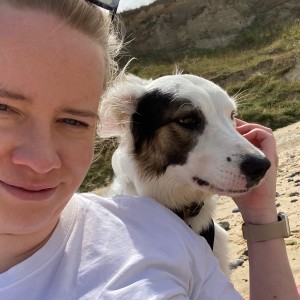
Orla Pentelow
Orla Pentelow is Kinship UK’s Senior Editor. She has previously written for British Vogue, Bustle, Yahoo and The Telegraph. When not at her desk liking dog videos she’s out and about with her rescue pup, Luna, who works primarily as chief distractor.
Related articles
![A dog running with a woman on a pier.]() opens in a new tab
opens in a new tab8 Questions to Ask Yourself When Choosing a Dog Breed
Find out which dog breed is right for your lifestyle
![A woman walking 5 dogs on leashes outside.]() opens in a new tab
opens in a new tabBreed Does Not Equal Behaviour
A study found that a dog’s breed accounts for less than 10 percent of their behaviour
![designer dog breed Labradoodle on a leash looking at the camera]() opens in a new tab
opens in a new tabFrom Goldendoodles to Puggles – the Truth About ‘Designer Dogs’
Do your research. Know your facts
- opens in a new tab
Prey Drive in Dogs: Fact or Fiction?
Is the term ‘prey drive’ correct terminology or meaningless jargon?

